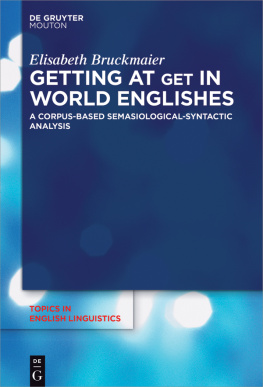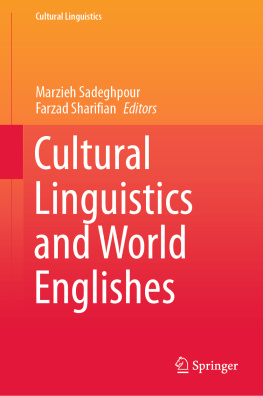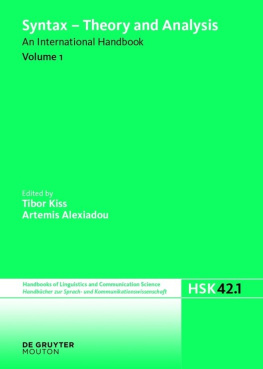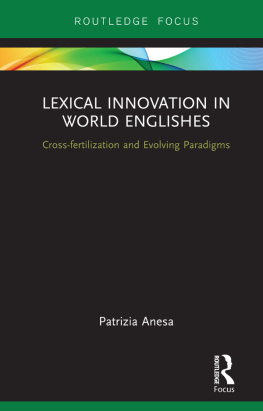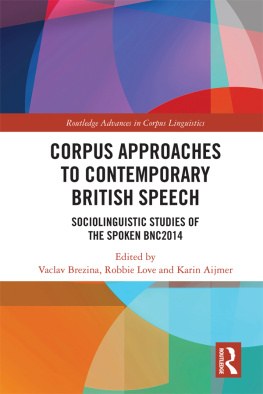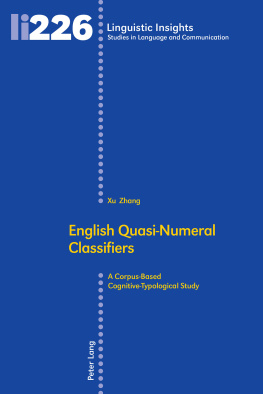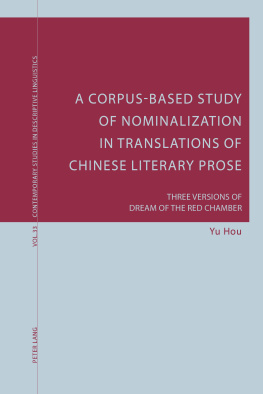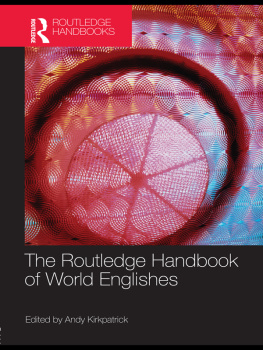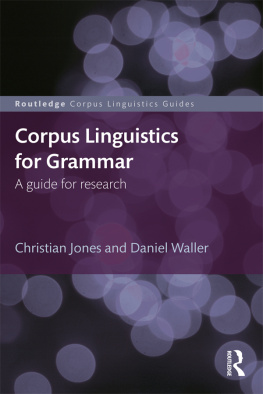Contents
Guide

Elisabeth Bruckmaier
Getting at GET in World Englishes
Topics in English Linguistics

Editors
Elizabeth Closs Traugott
Bernd Kortmann
Volume 95

ISBN 978-3-11-049599-7
e-ISBN (PDF) 978-3-11-049731-1
e-ISBN (EPUB) 978-3-11-049357-3
ISSN 1434-3452
Library of Congress Cataloging-in-Publication Data
A CIP catalog record for this book has been applied for at the Library of Congress.
Bibliografische Information der Deutschen Nationalbibliothek
Die Deutsche Nationalbibliothek verzeichnet diese Publikation in der Deutschen Nationalbibliografie; detaillierte bibliografische Daten sind im Internet ber http://dnb.dnb.de abrufbar.
2017 Walter de Gruyter GmbH, Berlin/Boston
www.degruyter.com
Acknowledgments
This book has grown out of my doctoral dissertation submitted at the LMU Munich in 2015. I would like to express my appreciation and thank Prof. Stephanie Hackert for supervising the thesis, as well as Prof. Hans-Jrg Schmid, who agreed to be my second examiner. The feedback received at various workshops and conferences was extremely valuable, and I am particularly grateful to the organisers and participants of the workshop Frequency effects in language contact held in Freiburg in June 2014. Many thanks are due to Prof. Bernd Kortmann for accepting the dissertation for the TiEL series, as well as to Kathleen Rabl and Tom Hawes for proofreading the manuscript. I also wish to express my gratitude to all colleagues and friends who stood by me during my time in Munich and encouraged me that I was on the right track. Special thanks go to my parents, who have spared no efforts to support me, to my brother and sister for their uplifting sense of humour and their encouraging presence, and to Alex for his continuing confidence. The present book is the result of two attempts: getting at GET and getting to grips with some of the complexities of life. Thanks to all who have helped me in both endeavours.
Abbreviations
| AdjP | adjective phrase |
| AdvP | adverb phrase |
| AmE | American English (in tables) |
| APiCS Online | Atlas of Pidgin and Creole Language Structures Online |
| ARCHER | A Representative Corpus of Historical English Registers |
| BNC | British National Corpus |
| BNCweb | BNC web version |
| BrE | British English (in tables) |
| EFL | English as a foreign language |
| ENL | English as a native language |
| ESD | English as a second dialect |
| ESL | English as a second language |
| eWAVE | The Electronic World Atlas of Varieties of English |
| FLOB | Freiburg-LOB Corpus |
| Frown | Freiburg-Brown Corpus |
| GloWbE | Corpus of Global Web-Based English |
| ICE | International Corpus of English |
| ICE-GB | ICE-Great Britain |
| ICE-JA | ICE-Jamaica |
| ICE-SIN | ICE-Singapore |
| itr | intransitive (in tables and figures) |
| JamE | Jamaican English (in tables) |
| LOB | Lancaster-Oslo/Bergen Corpus |
| LSWE | Longman Corpus of Spoken and Written English |
| MI | Mutual Information |
| NE | New English (in tables) |
| NP | noun phrase |
| OED | Oxford English Dictionary |
| phrprepv | phrasal-prepositional verbs (in tables and figures) |
| phrv | phrasal verbs (in tables and figures) |
| pmw | per million words |
| PP | prepositional phrase |
| prepv | prepositional verbs (in tables and figures) |
| PV | particle verb |
| sb | somebody |
| SingE | Singaporean English (in tables) |
| SLA | second language acquisition |
| SOV | subjectobjectverb |
| sth | something |
| SVA | subjectverbadverbial |
| SVC | subjectverbcomplement |
| SVO | subjectverbobject |
| SVOA | subjectverbobjectadverbial |
| SVOC | subjectverbobjectcomplement |
| tr | transitive (in tables and figures) |
| V | verb (in tables) |
| VP | verb phrase |
List of figures
List of tables
1Introduction
1.1G ET : origins and previous research
The major reference dictionary of English, the Oxford English Dictionary (OED) (2009: s.v. get, v.), has 81 entries for GET in verbal use, not counting draft entries. In the book version (1989), this amounts to ten full pages reserved for GET . G ET is adopted from Old Norse geta to get, to obtain, to beget, to guess, and, in the form of geten , first used as a simple lexical verb in the Middle English period. In Old English, only compounds with *-gietan existed, e.g. forgietan . The Indo-European root *ghed/*ghod to seize, to take hold of is also found in Latin prehendere to catch, to lay hold of and Greek to hold, to contain, to be able. During the Middle English period, the original Old Norse e vowel of the past participle changed to o by analogy, yielding gotten , and in the 16 th century, also the past tense form gat assumed the o vowel. By the 17 th century, got and gotten were the usual forms. In England, gotten was then superseded by got , while it has remained common in the US.
Why is this attempt being made to get at GET ? Pursuing research on verbs with the meaning to get is motivated by
[] their high frequency, their formal and semantic complexity, their high variability in intra- and interlingual comparisons and (from a historical or panchronic perspective) their susceptibility to semantic extension and also to grammaticalization. [] As GET verbs are highly dynamic verbs, their semantic and grammatical changes as well as their synchronic variation offer many research opportunities. (Lenz and Rawoens 2012: 1075)
Applying this to English, Kirchner (1952), as early as the middle of the 20 th century, attempted a comprehensive syntactic and semantic analysis of ten of the most important verbs in British and American English, among them GET , and placed special focus on idioms of which they are a part. His description of GET alone amounts to 70 pages.
Firth (1968: 12, 18), too, very early used GET to exemplify his contextual approach to meaning, stating that the traditional categories and assumptions of semantics, such as that single words and sentences could be safely examined as for their meaning without regarding their environment, are inadequate and must be replaced by abstractions that use the larger contexts of the words and describe whole systems derived from contextualised structures. G ET , Firth concluded, has a unique position (1968: 22) in the English language:
Get is formally involved and widely distributed in a large number of collocations functioning in creative, possessive and highly conative situations. It is easy to understand why taboos grew up about this word of power, especially among puritans and schoolmasters. (1968: 23)

